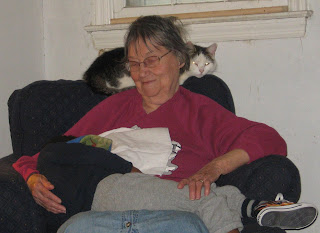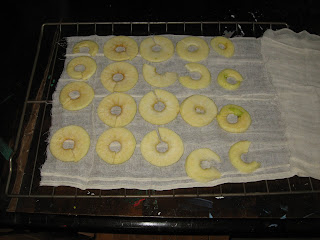She is ten years old, has survived many a fight and having her back leg bit completely through, breaking the bone. It took her three days to come home, and by that time she had a horrible infection and the bone could not be set, so Dave and I washed it out two or three times a day with warm water and iodine and kept her confined. Boy was she mad about the cage. She healed up so nicely that you would never know about the leg, unless you looked at her when she was walking and noticed that back leg was crooked. Even at her advanced age she is perky and still a terrific mouser and chaser down of voles. We get our fair share of presents! But the things I love most about kitty is what she does for Dave's mom, who stays with us during the winter. Because Nana is available all day, she is now kitty's best friend, who lets her in and out when she meows, keeps her feed bowl full and provides hours of petting and a soft lap to nap on. Nana even puts down her crochet hook when Alli comes to call.
As you can see, she even helps when Nana has a grandchild to hold for a nap. Alli wasn't always to have "her" napping place taken by someone else! However, the day Nana went back up north for the summer, Alli laid in her chair all day, waiting for her Nana to come back. She had a rough summer without someone attending to her every desire, but she did make it and is enjoying Nana again. There are lots of studies out that suggest having pets is good for the elderly; it gives them companionship, and if they are involved in pet care, they have a sense of purpose and once again have someone depending on them. It can help make a long day more purposeful. Our situation is an ideal one because the animals are really ours, and in the long run, we are responsible for their upkeep and care; I wouldn't suggest just getting a companion pet for someone who lives on their own because it might be more than they could handle and become a burden.
Kitty is the main pet that Nana cares for, but she does keep food and water out for the "puppies" who are entering their fifth year. They aren't siblings, but we got a puppy for each of our kids at the same time; not our brightest moment.
However, we have two energetic dogs who spend part of their time outside and part of their time inside with us. The especially like to visit Nana, who has a tin of treats on her table, and makes sure everybody gets their biscuit every day. We do have to make sure they have settled down so they don't accidentally scratch her, she does not heal as quickly as she used to. Everybody loves Nana. She always has time to pet the Lab, who would sit and be petted all day if we didn't take her outside; Winry has learned some manners and no longer jumps up (or not often) but sits, impatiently wiggling, until the person she is pleading with notices, or until she gets too impatient and barks.
We will be adding more critters to the farm in the city in the next few months, critters with a bit more purpose, such as egg laying, and I'm looking forward to seeing how they impact our family. So far the addition of two dogs and a cat have been a good thing, though not without problems, I hope chickens and bunnies are just as beneficial.















































